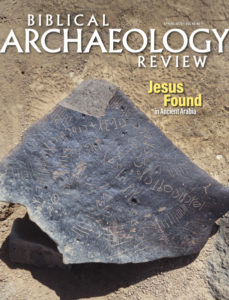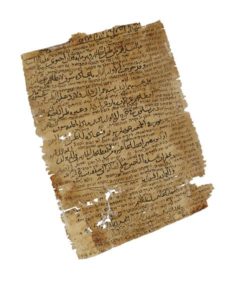Text Treasures: Cairo Geniza
300,000 documents found in an attic storeroom
Marek Dospěl June 01, 2022 0 Comments 861 views



The Ben Ezra Synagogue in Old Cairo harbored a millennium-worth of Jewish writings.
Credit: Roland Unger, CC BY-SA 3.0, via Wikimedia Commons
The storeroom—accessible only by ladder from the women’s balcony of the synagogue—was never really forgotten, so we are perhaps unjustified in talking about its discovery. Starting in the 1880s, however, scholars from Jerusalem, England, and elsewhere learned of the existence of the documents and thus began to empty the storeroom of some of its contents. Among the early visitors were the Scottish twin sisters Agnes Smith Lewis and Margaret Dunlop Gibson, who upon their return to Cambridge, in 1896, showed their documents to the great scholar of Jewish studies, Solomon Schechter. The documents included a page of the Hebrew original of the book of Ben Sira and inspired Schechter to travel to Cairo. With permission of the rabbi of the synagogue, Refael Aharon Ben-Shimon, himself an important scholar, Schechter was able to remove the remaining contents of the Cairo Geniza.a


CAMBRIDGE UNIVERSITY LIBRARY, T-S AR .41.131
A palimpsest—a document in which the original writing has been scrapped or wiped off in order to reuse the page, but traces of the original remain—showing 13 lines of an Arabic petition concerning land, from c. 1150 C.E., which was later reused to write down Jewish liturgical poems.
Built between 1025 and 1041, the Ben Ezra Synagogue served the local community for more than 900 years—thus explaining the enormous volume of accumulated writings—until it was decommissioned during the 1960s. The survival of the documents owes to the fortunate confluence of multiple factors, including favorable climate with stable humidity levels; the omnipresent dust from local limestone containing high levels of calcium carbonate, which naturally aids the preservation of paper, parchment, and ink; and the fact that the storeroom was apparently large enough that it never needed to be emptied.
The text treasures of the Cairo Geniza cover more than a millennium of history. While the latest documents date from the 19th century, the earliest recovered writings predate the founding of the synagogue by centuries. This is due to the practice of repurposing old documents (often as palimpsests) and because sturdy parchment Torah scrolls may be used for centuries and, in the present instance, clearly were transferred from an older synagogue to the then newly built Ben Ezra. Dating as far back as the fifth or sixth century, the earliest writings in the geniza survived because they were reused as scrap paper to record new texts.


No other geniza or archive (ancient or medieval) can compare in size and diversity to the Cairo Geniza. Only the Oxyrhynchus Papyri—a monumental collection of papyri dated to the Greco-Roman period from the Egyptian city of Oxyrhynchus—comes close, with 86 volumes of edited texts published so far. The largest single grouping of Geniza documents is now in the Cambridge University Library. With its approximately 200,000 documents, it is also the world’s largest collection of medieval Jewish manuscripts. The remaining documents are held in about 70 different museums, libraries, and private collections around the world.
The Cairo Geniza is unique also in that it contains much more than the usual sacred Hebrew books, such as biblical and Talmudic texts, prayer books, and compendia of Jewish law. For some reason, the Jews of Cairo also kept writings from many secular genres (grammar, lexicography, poetry, philosophy, etc.) as well as quotidian and ephemeral documents, such as receipts, medical prescriptions, recipes, marriage contracts, leases, private letters, and school writing exercises. Besides texts in Hebrew, the cache contains writings in Aramaic, Judeo-Arabic, Judeo-Greek, Judeo-Spanish, Judeo-Persian, Judeo-German (Yiddish), Greek, and Arabic. The polyglot documentation indicates the Cairo community’s contacts with other Jewish communities around the world.
Writings recovered from the Cairo Geniza offer a window on the Jewish community of medieval and early modern Cairo but also the wider economic, social, and cultural history of the Mediterranean world. They bring to life Jewish customs and daily concerns of a minority living under the rule of Muslim dynasties. A sizable number of the palimpsests astonishingly include Arabic documents that emanated from the state administration of the Fatimid rulers of Egypt (969–1171) and allow an unparalleled view of the early Islamic state. The example on the opposite page shows 13 lines of an Arabic petition concerning land, from c. 1150 C.E., which was later reused to write down Jewish liturgical poems called piyyutim, in Hebrew.
There is no single publication series working toward a complete edition or translation of the Geniza documents. The sheer magnitude and diversity of the corpus favor discrete linguistically and subject-focused projects. Several digital initiatives provide access to the myriad of dispersed fragments and facilitate their identification, cataloging, transcription, and translation. They include the Friedberg Genizah Project, the Taylor-Schechter Genizah Research Unit at Cambridge University Library, Princeton Geniza Project, and Penn/Cambridge Genizah Fragment Project. Stefan Reif’s A Jewish Archive from Old Cairo: The History of Cambridge University’s Genizah Collection (Routledge, 2000) and Sacred Trash: The Lost and Found World of the Cairo Geniza, by Adina Hoffman and Peter Cole (Schocken, 2011), provide accessible introductions. You can also watch Michelle Paymar’s 2018 documentary From Cairo to the Cloud: The World of the Cairo Geniza.—M.D.
Notes:
a. See Molly Dewsnap Meinhardt, “The Twins and the Scholar,” BAR, September/October 1996.
Read more in Bible History Daily:
All-Access members, read more in the BAS Library:
Not a BAS Library or All-Access Member yet? Join today.

